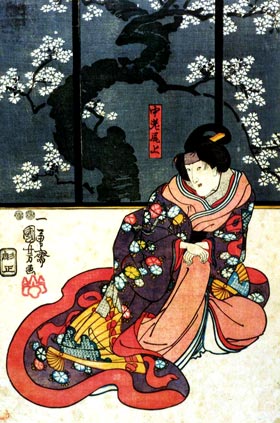| KAGAMIYAMA |
| Play title | Kagamiyama Koky˘ no Nishikie |
| Author | Y˘ Y˘dai |
| History |
The play "Kagamiyama Koky˘ no Nishikie" was originally written for the puppet theater (Bunraku) in 1782. It was adapted for Kabuki the following year and staged for the first time in the 4th lunar month of 1783 at the Moritaza [casting]. It mixed two real events: |
| Structure |
The original puppet play was in eleven acts. From the original puppet play, the Kabuki versions used act VI and VII, the two main acts focusing on the ladies-in-waiting suicide/revenge story. The current Kabuki version is made up of 5 acts divided into 7 scenes. |
| Key words | Jidaimono Gidayű Ky˘gen Adauchi S˘d˘ Z˘ri Z˘riuchi Kagamiyamamono Oiemono |
| Summary |
Act II: the Beating with the Bamboo Sword The overbearing senior lady-in-waiting Iwafuji challenges the middle lady-in-waiting Onoe to show her fighting skills, the sign of a true samurai woman, hoping to ridicule Onoe's origins since she is the daughter of a wealthy commoner. But Onoe's maidservant Ohatsu saves her mistress by fighting in her place, claiming that she learned everything from Onoe. Iwafuji becomes even more determined to destroy Onoe since she is an obstacle to her goal of controlling the clan. Act III: the Beating with the Z˘ri Sandal Onoe has been entrusted with a precious Buddhist statue, but when she is asked to present it, finds that it has been replaced with a z˘ri sandal, the result of Iwafuji's plotting. Iwafuji beats Onoe with the sandal in front of all the other women. Despite the injustice of the accusation, Onoe can no longer live with this shame and, as she leaves, full of grief and anguish, shows her determination to die. Act IV, Scene 1: in the Mansion Corridor and in Onoe's Room Ohatsu hears about the terrible things that have happened from the gossip of others women. Ohatsu is desperate to rescue her mistress, but despite her efforts to cheer her up and stay by her side, Onoe forces her to leave with a letter. Act IV, Scene 2: the cry of the crow outside the Walls Ohatsu is worried by all the bad omens that she sees and hears: a lantern which goes out, the croak of a crow... She encounters a fight and accidentally the letter box opens revealing a suicide note and the fateful z˘ri sandal. Ohatsu rushes back to Onoe. Act IV, Scene 3: Onoe's Room But it is too late, Onoe has already committed suicide. Ohatsu tearfully takes care of the body and then vows to carry out her mistress's revenge on Iwafuji. Act V: the Revenge in the Garden of the Palace Ohatsu finds Iwafuji in the garden and says that Onoe has suddenly become ill. Iwafuji knows that Onoe is dead and is immediately suspicious. She agrees to help, but then claims to be suffering cramps. Ohatsu says that she has an amulet to cure her and beats Iwafuji with the fateful z˘ri sandal. The two fights and Ohatsu kills Iwafuji, defeating her plans to take over the clan. The lord of the clan praised Ohatsu and rewards her by giving her Onoe's name and allowing her to succeed to her late mistress's position. Source: Earphone Guide website |
| Comments |
"Kagamiyama" is the ultimate play about rivalry and revenge in the women's quarters of a samurai mansion. It is said to be based on life in the Sh˘gun's castle since the original play was written by a doctor familiar with things in that exalted realm far from the eyes of the common people. Other women in samurai service no doubt were deeply moved by the problems of characters in situations very similar to their own. From the Earphone Guide website Three onnagata r˘les in "Kagamiyama" (lit., Mirror Mountain) provide sharp contrasts in the types of women. Iwafuji is a wicked maid in the household of a feudal lord, while ranking below her is Onoe, all that is gentle and good. Jealous of the virtues and accomplishments of Onoe, the evil Iwafuji intrigues, and her plot succeeds so well that the good maid is disgraced beyond all hope of redress. There is no way in which Onoe can clear herself, and she takes her life. Ohatsu, servant to Onoe, true-hearted and valorous, heedless of the consequences, meets Iwafuji in the garden and fights to a finish, the bad Iwafuji dying to the satisfaction of the audience, while the young lord of the mansion appears to approve Ohatsu's action, and promotes her to the position in the household her mistress enjoyed. ZoŰ Kincaid in "Kabuki, the Popular Stage of Japan" |
| Trivia |
"Kagamiyama" is often staged in March. In the Edo period, March was a time when the women serving in samurai mansions were given a rare opportunity to go back to their homes and spend some time free from the strict demands of service. They flocked to the kabuki theatres which featured programs calculated to appeal to female audiences. This play is nicknamed "Onna Chűshingura", "the Women' Chűshingura". |
 |
 |
|
The actors Iwai Kumesabur˘ III and Nakamura Utaemon IV playing the roles of Onoe and Iwafuji in the drama "Megumi ni Uru˘ Iwafuji", which was staged in the 4th lunar month of 1849 at the Ichimuraza (print made by Utagawa Kuniyoshi) |
|
|
|
| Contact | Main | Top | Updates | Actors | Plays | Playwrights | Programs | Links | FAQ | Glossary | Chronology | Illustrations | Prints | Characters | Derivatives | Theaters | Coming soon | News |